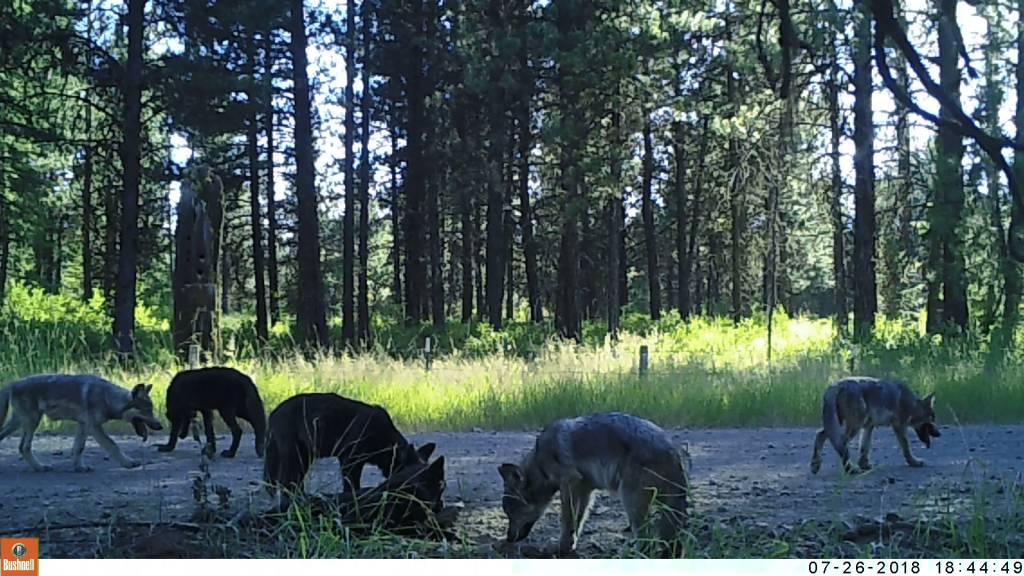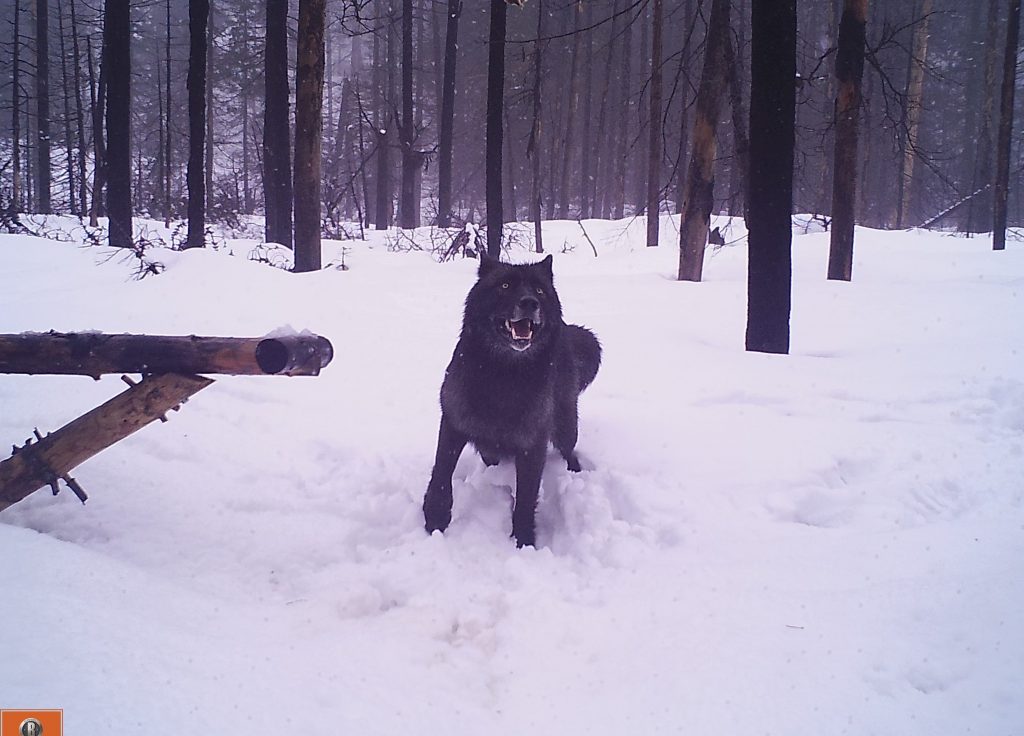
Washington Wolf Count Rises Yet Again, Up 11 Percent
No surprise as Evergreen State wolf numbers continue to grow, with the minimum count up 11 percent over 2018 to — at the very least — 145 wolves across the state, according to WDFW’s annual report released today.
This year’s figures do come with a caveat, as tribal wildlife managers on a huge North-central Washington reservation consider the species recovered there and are now putting less effort into tallying wolves.

Indeed, wolves are federally recovered throughout the eastern third of Washington, and both WDFW and the Colville Tribes report overall increases over the previous year — from 97 wolves to 108 in state-managed areas at the end of 2019, and from 28 to 37 on the reservation.

The growth reflects the 11th straight year of population gains for the apex predator species and comes despite nine wolves being removed by WDFW in response to livestock depredations, the legal harvest of six by tribal hunters, the justified shooting of two caught in the act of pursuing livestock, as well as several other deaths, including another by a cougar and one under investigation.

“The population continuing to recover is good news for wolf conservation but it can also bring additional challenges. Last year was particularly tough for wolf-livestock conflict management,” said WDFW Director Kelly Susewind in a press release. “We are working with citizens and communities to strike a balance so both livestock producers and wolves can share the landscape and thrive in Washington.”
WDFW reports 21 state packs and 10 successful state breeding pairs, compared to 22 and 11 in 2018. The Colvilles said they have five packs but did not report breeding pairs, though head counts of five, six, six, seven and nine for their quintet suggest there were probably several.
When news came out last month that the Colville Tribes would not be doing a year-end count, there was some worry that it might cause the state’s annual tally to drop, opening yet another avenue for pro-wolf fans to criticize Washington’s management.
But ultimately, tribal managers did provide some population info for the annual report, which WDFW characterized it thusly:
“The CTCR considers the population of wolves on their lands recovered and did not allocate resources into year-end counts for 2019. Numbers provided by CTCR reflect winter numbers incidentally gathered by biologists, hunters, trappers, and public observations rather than dedicated efforts to count wolves that include year-end track, aerial, and camera surveys conducted by WDFW and other co-managers for 2019. Therefore, it should be noted that these numbers are not comparable to previous year’s numbers and come with less certainty.”

WDFW’s annual report uses the word “minimum” around two dozen times to describe the count, and it openly acknowledges that “the actual number of wolves in Washington is likely higher.”
The count is done in winter, the low population ebb of wolves’ life cycle, and in the coming months many pups will be born, inflating the population temporarily. Since 2008, when the first pack, the Lookouts, were confirmed, minimum wolf numbers have grown at an average annual rate of 23 percent.
As for 2019’s new packs, there were two, including one in central Okanogan County, a pair known as the Sullivan Creek wolves and which roam south of Loup Loup Pass between the lower Methow and Okanogan Valleys.

Unsurprisingly, there are also new occupants of a troubled landscape, the Kettle Pack, taking over in that part of Ferry County where the Old Profanity Pack was terminated last summer, and the Profanity Peaks before them.
Last year wolves were confirmed to have killed 14 cattle and injured another 11 statewide, mostly during the summer grazing season, though three cows “left behind” on Forest Service grazing allotments in 2018 were killed in January 2019, WDFW reported.
“We had more negative impacts to cattle and lethal removals last year than we’d like to see. It’s been a challenging situation, but ranchers are continuing to play an important role in reducing wolf-livestock conflict,” said WDFW wolf policy lead Donny Martorello. “And we are starting to see local, grass-root efforts to improve the use and effectiveness of non-lethal deterrents.”
While cattle mortalities reached their highest level yet last year, the overall number of depredations was seven less than 2018’s 32 deaths and injuries.
“WDFW spent a total of $1,518,659 on wolf management activities during 2019, including $134,937 in reimbursement to 33 livestock producers for Damage Prevention Cooperative Agreements–Livestock (DPCA-L) non-lethal conflict prevention expenses (range riding, specialized lighting and fencing, etc.), $251,100 for 11 contracted range riders, $8,773 to two producers for livestock losses caused by wolves, $30,103 to one producer for indirect losses, $128,613 for lethal removal operations in response to depredations on livestock, and $965,133 for wolf management and research activities,” the annual report states.
No dollar figure was specified for court costs as hardcore wolf advocates sought to block WDFW from taking out chronic problem wolves by taking the agency before superior court judges in two separate counties.
Ultimately, Governor Jay Inslee stepped into WDFW wolf management as a result of depredations and removals in the Kettle Range last year, ordering that nonlethal tactics be utilized more and the killing of wolves “significantly” reduced.
Overall, 85 percent of packs stayed out of known trouble with ranchers.
Most wolves do remain in Northeast Washington.
“If I were a wolf, I’d be comfortable in Stevens County. You have an endless supply of Red Hereford cattle,” Scott Nielsen, president of the local cattlemen’s association, told the Capital Press.
Conservation Northwest said it viewed the latest count “with a mix of optimism and caution.”
“While we’re glad to see another year of wolf population growth and we remain optimistic overall, it’s concerning that progress towards recovery continues to be slow in the Cascades and Western Washington,” said Paula Swedeen, Ph.D., Conservation Northwest Policy Director and a representative on the state’s Wolf Advisory Group in a press release. “We hope to see more overall spread of the population, growth of breeding pairs, and lower levels of livestock depredations and lethal removal in 2020.”
A total of 19 wolves in 14 different packs were captured by state, tribal and federal wildlife biologists in 2019, with all but one of those — a pup — fitted with either GPS or VHF tracking collars.
While at one time or another nearly two-thirds of Washington’s packs were being monitored last year, given dispersals, mortalities, device “releases” or failures, by the end of 2019 only 12 working collars were out there on animals in 10 different packs, or 38 percent of wolf groups.
Speaking of dispersals, there were at least six last year, with some wolves traveling further than others.
A Loup Loup male headed west into the Pasayten Wilderness, across Ross Lake and to somewhere near Mt. Baker before turning around and apparently settling down just north of the Washington-British Columbia border
Individuals with the Grouse Flats and Strawberry Packs appear to have joined nearby packs in Northeast Oregon and Northeast Washington, respectively.
A Stranger female went south, circled Fairchild Air Force Base, went back to its central Stevens County territory then headed east into Idaho where it was legally harvested south of Lake Pend Oreille.
A Carpenter Ridge male got itchy feet in early October and crossed into North Idaho and Northwest Montana, bypassed Missoula and Helena, and was legally harvested in the Little Belt Mountains between Great Falls and White Sulphur Springs.
And in April, a Goodman Meadows female headed north into British Columbia to the Radium Hot Springs area and was found dead in November of unknown causes.

Outside of the time frame of the 2019 report, there are recent indications of wolves elsewhere in Washington, including “activity” in the Cooper Ridge area on the southeastern border between Chelan and Okanogan Counties, “images of wolves” south of Lake Chelan, and a pair in the Vulcan Mountain area of northern Ferry County, according to WDFW’s March wolf update.
Even as confirmed successful breeding pair numbers are low in the Northern Cascades recovery region and absent in the Cascades/Northwest Coast region, last August WDFW began planning for how to manage wolves after they do reach recovery goals — at least four breeding pairs in each of the three recovery zones, plus three anywhere — marking the beginnings of a shift from 2011’s management plan for rebuilding a population that is state-listed as endangered.
Right now that effort is in the scoping process and earlier this month WDFW summarized what it heard in the nearly 7,800 comments from the public, with wolf conservation and monitoring, depredations, and hunting identified as the three most important topics. Translocation was among the least important.


While the agency cautioned that the survey wasn’t a “voting mechanism,” residents of Washington’s wolf country did register their thoughts at higher rates than those in urban and farming counties. Overall, 47 percent of comments came from Washingtonians, but East Coast and California residents weighed in as well.

With the help of tribal and federal agencies, WDFW has submitted annual wolf reports since 2009.
As with past ones, the latest also includes a review of the bevy of research being driven by the recolonization of wolves, including impacts on deer, elk and other game species, plus details on lethal removal operations.
To the south, last week ODFW reported its count also rose to a minimum of 158 at the end of 2019, a 15 percent increase over the previous year.

